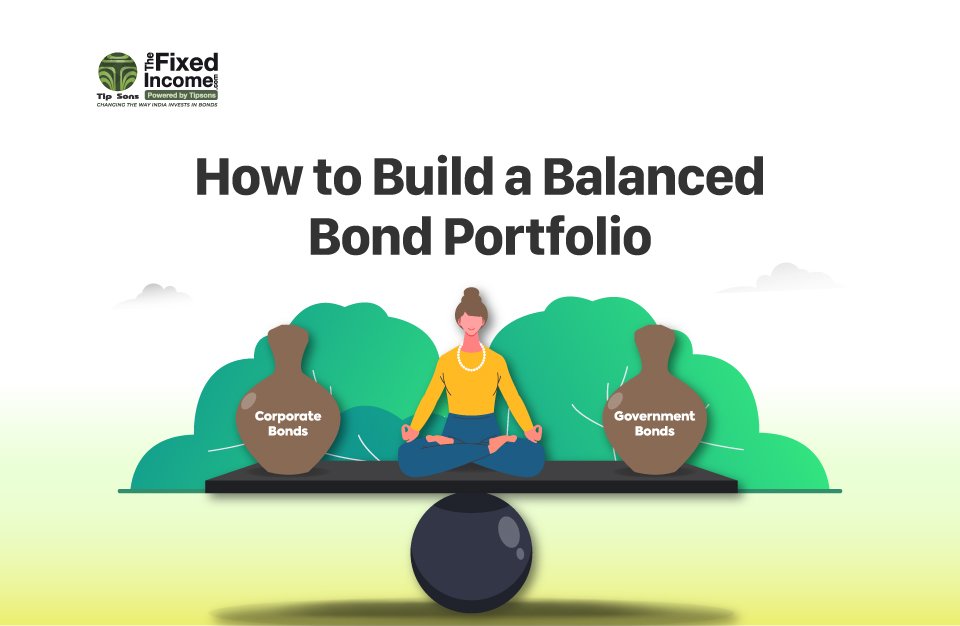Overview
Building a well-balanced portfolio is of primary importance for a well-rounded investment strategy. A balanced portfolio comprises all your investments, such as stocks, mutual funds, ETFs, bonds, real estate, gold, and other accounts. It is necessary to help you manage your risk and achieve your long-term goals.
It is suggested to devote some part of your portfolio to fixed-income instruments that provide stability and steady returns. A balanced portfolio can provide stability and income, even in volatile market conditions. Diving deeper, it is important to create the right mix of bonds in the portfolio. This article will guide you through the fundamental steps to craft a balanced bond portfolio that aligns with your investment goals and risk tolerance.
Let’s dive into the steps now.
Step 1: Clarify Your Investment Goals and Risk Tolerance
The first step in building a balanced bond portfolio is to define your investment goals, time horizon, and capital requirements. It depends on whether you want to preserve capital, generate income, or achieve long-term growth. Your goals will determine the types of bonds you include in your portfolio.
The next step is to assess your risk tolerance. Bonds are generally less risky than stocks, but not all bonds carry the same level of risk. Government bonds are low-risk, while high-yield bonds carry significant risk. Your risk tolerance will help determine the right mix of bonds for your portfolio.
Step 2: Diversify Your Bond Portfolio
Diversification is mitigating risk by spreading your investments across various asset classes. There is little correlation or even an inverse correlation between different asset classes. For instance, when equities are performing well, bonds, real estate, and commodities might not be going strong. During a stock market downturn, other assets such as real estate or bonds might offer above-average returns.
Diversification applies to bonds as well. By diversifying your bond portfolio, you can spread risk and reduce the impact of any single bond defaulting. The following are some of the strategies for diversification:
- Diversify by Bond Type: Your portfolio should include a mix of bonds such as government, municipal, corporate, and high-yield bonds. This approach balances the safety of government bonds with the higher yields of corporate and high-yield bonds.
- Diversify by Maturity: Bonds have different maturities, ranging from short-term (less than 3 years) to long-term (more than 10 years). A balanced bond portfolio should include bonds with varying maturities to manage interest rate risk.
- Diversify by Issuer: Don’t put all your eggs in one basket. Invest in bonds issued by different corporations, sectors, etc. This reduces the risk associated with any single issuer defaulting.
Step 3: Determine the Appropriate Asset Allocation
You can hedge against risk in one asset class by simultaneously holding investments in other classes. This strategy of mitigating portfolio risk through diversification across different asset classes is known as asset allocation.
Diversification should be done within the bonds also. The allocation of bonds in your portfolio is determined based on your investment goals, risk tolerance, and time horizon. A conservative investor with a low-risk tolerance may allocate a higher percentage of their portfolio to government bonds, while a more aggressive investor who can take on more risk, might allocate a smaller portion to it and invest more in high-yield bonds for getting higher returns.
Step 4: Regularly Rebalance Your Portfolio
Once you’ve built your bond portfolio, it’s essential to monitor and rebalance it regularly. Over time, the value of your bonds may fluctuate due to changes in interest rates, credit ratings, or economic conditions. Rebalancing helps in maintaining your portfolio aligned with your investment goals and risk tolerance.
For example, if your portfolio’s bond allocation has shifted from 50% to 40% due to a rally in the stock market, you may need to sell some stocks and buy more bonds to restore the original allocation.
Step 5: Consider Bond Funds and Bond Baskets
Investing solely in individual bonds may be challenging for investors having limited capital. Bond baskets or Bond Funds are alternative means of diversification.
A bond basket is a collection of multiple bonds structured into a single investment product with a similar theme or specific criteria. In comparison, a bond fund or debt fund is simply a mutual fund that invests primarily in bonds and debt instruments like government, corporate, municipal, and convertible bonds, as well as asset-backed securities. It offers diversification with a low minimum investment and typically features monthly interest payments.
Bond prices and interest rates are inversely related, meaning long-term bonds have higher interest rate risk compared to short-term bonds.
Step 6: Monitor Credit Ratings and Economic Indicators
Credit ratings also play an important role in building a bond portfolio. Bonds with higher credit ratings (AAA, AA) are considered less risky compared to those with lower ratings (BBB, BB, or lower) which carry higher risk.
Conclusion
Building a balanced portfolio investment portfolio helps in achieving your goals and risk tolerance but requires a significant amount of time and knowledge. It requires careful planning, diversification, and ongoing monitoring.
Investors should also keep abreast of economic indicators such as GDP growth, inflation, and unemployment rates. These indicators can provide insights into the overall health of the economy that influences interest rates and bond prices and help ensure that your bond portfolio remains well-positioned to market fluctuations.
Whether you’re a conservative investor seeking stability or an aggressive investor looking for higher returns, a balanced bond portfolio can play a crucial role in achieving your financial objectives.
Regularly rebalancing your portfolio and staying informed about economic indicators will help ensure that your bond portfolio remains well-positioned to weather-changing market conditions.
Disclaimer: Investments in debt securities/ municipal debt securities/securitized debt instruments are subject to risks including delay and/ or default in payment. Read all the offer-related documents carefully.
FAQs
- What is a bond portfolio?
Ans: A bond portfolio includes a collection of bonds such as government bonds, municipal bonds, corporate bonds, and high-yield bonds, held by an investor to generate income and manage risk.
- What are the benefits of diversifying my bond portfolio?
Ans: There are many benefits of diversifying a bond portfolio. They reduce the impact of any single bond defaulting or underperforming.
- Why should bonds be part of my investment portfolio?
Ans: Bonds provide stability and income, especially during market volatility. They help to preserve capital and offer diversification, thereby mitigating overall portfolio risk.
- How often should I rebalance my bond portfolio?
Ans: It’s recommended to review and potentially rebalance your bond portfolio at least annually or whenever there are significant changes in the market or your financial situation.
- How do I determine my risk tolerance for bond investments?
Ans: Your risk tolerance depends on various factors such as your financial goals, investment timeline, comfort level with market fluctuations, and overall financial situation. Evaluating these factors can help you in selecting the right mix for your portfolio.






